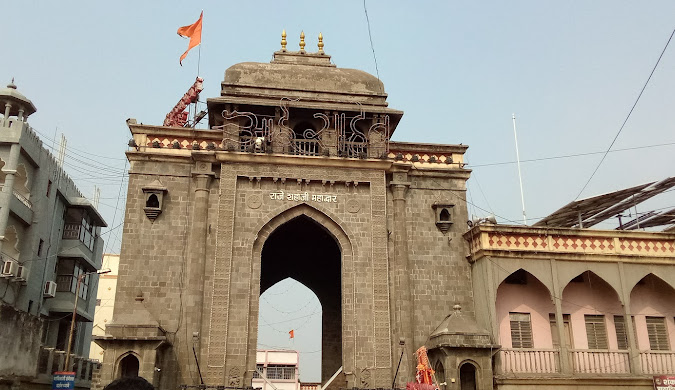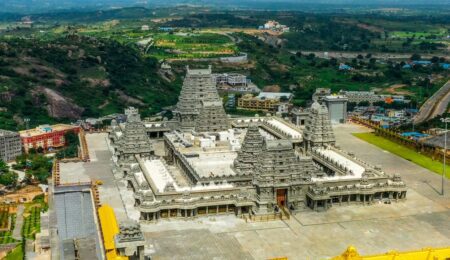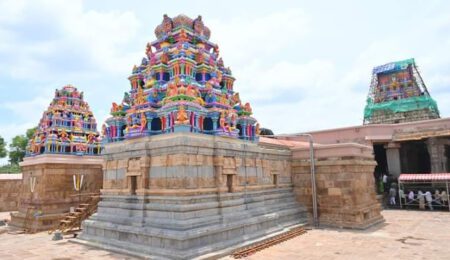Tuljapur: A Pilgrim’s Guide to Tulja Bhavani Temple, Live Darshan, and Travel Distances
Tuljapur: The Skanda Purana describes the incarnation story of Goddess Tulja Bhavani as follows:
During the Krita Yuga, after the death of Sage Kardama, his wife Anubhuti decided to perform sati (self-immolation) along with her husband. However, since she had a young son, the other sages advised her against it. Understanding her responsibility, she abandoned the idea and went to the banks of the Mandakini River, where she engaged in deep penance and devotion.
At that time, a demon named Kukur tried to disrupt her penance and chastity. In distress, Anubhuti prayed to Goddess Bhagavati for protection. The Goddess then manifested and slayed the demon, restoring peace. Upon Anubhuti’s request, the Goddess decided to permanently reside on Yamunachal (Bala Ghat) mountain, which is where the present-day Tulja Bhavani Temple stands.
Significance of Goddess Bhavani
In India, there are three principal abodes of the Trigunatmika Adi Shakti, each representing one of the three fundamental qualities (gunas):
- Mahakali in Kolkata – Symbolizing Tamas (destruction and power)
- Mahalakshmi in Kolhapur – Symbolizing Rajas (prosperity and activity)
- Mahasaraswati in Mahur – Symbolizing Sattva (knowledge and purity)
Tulja Bhavani Temple: History and Significance
The Tulja Bhavani Temple Tuljapur Maharashtra is believed to date back to the 12th century. Legend says Goddess Bhavani appeared here to slay the demon Mahishasura. The temple’s architecture reflects a blend of Hemadpanthi and South Indian styles, with intricate carvings and a gold-plated pinnacle.
Key Features:
- The idol of Goddess Tulja Bhavani, carved from a single stone.
- A sacred Yagna Kund (fire pit) for rituals.
- Festivals like Navaratri, Chaitra Purnima, and Diwali celebrated grandly.
Live Darshan of Tulja Bhavani Temple
For devotees unable to visit physically, live darshan Tuljapur offers a virtual connection to the deity.
How to Access Live Darshan Tuljapur:
- Visit the temple’s official website or YouTube channel.
- Tune in during morning aarti (6:00 AM) or evening aarti (7:30 PM).
- Special live streams during festivals and auspicious days.
Benefits:
- Participate in rituals remotely.
- Seek blessings from anywhere in the world.
Tuljapur Travel Guide: Distances and Routes
1. Solapur to Tuljapur Distance
- Distance: 45 km via NH65.
- Travel Options:
- By Road: Buses and taxis (1 hour).
- By Train: Nearest station is Osmanabad (40 km from Tuljapur).
2. Tuljapur to Akkalkot Distance
- Distance: 40 km via Solapur-Akkalkot Road.
- Travel Tips: Hire a taxi or take a bus (1–1.5 hours).
3. Pandharpur to Tuljapur Distance
- Distance: 120 km via Solapur-Pandharpur Highway.
- Travel Options: Direct buses (3 hours) or private cabs.
4. Akkalkot to Tuljapur Distance
- Distance: 40 km (similar to Tuljapur-Akkalkot route).
- Highlights: Combine your pilgrimage with a visit to Akkalkot’s Shri Swami Samarth Temple.
How to Reach Tuljapur
- By Air: Nearest airports: Aurangabad (180 km), Pune (250 km).
- By Rail: Nearest major station: Solapur (45 km).
- By Road: Well-connected to Solapur, Pune, and Mumbai via NH65.
Nearby Attractions
- Osmanabad Fort: A historic fort 20 km away.
- Naldurg Fort: 60 km from Tuljapur.
- Pandharpur: Visit the Vitthal Temple en route.
FAQs
Q1: What is the best time to visit Tuljapur?
A: October–March for pleasant weather.
Q2: Is there parking near Tulja Bhavani Temple?
A: Yes, paid parking is available 500 meters from the temple.




Leave a Comment